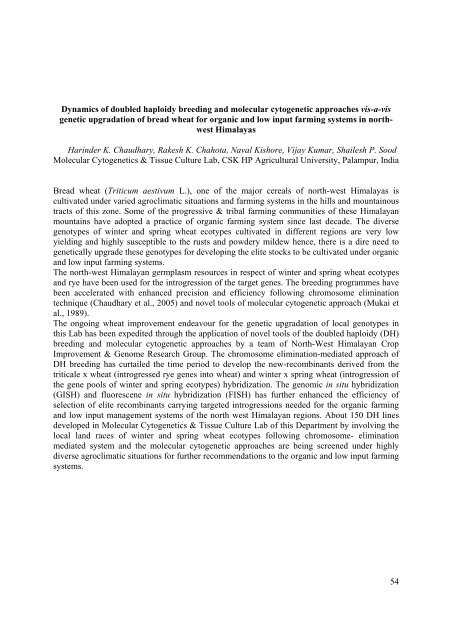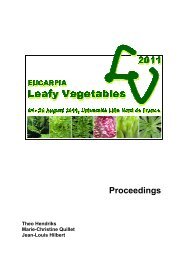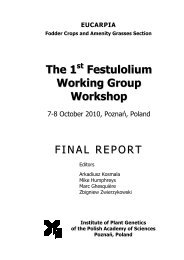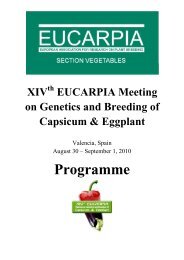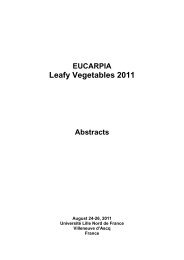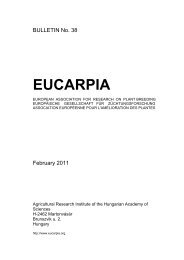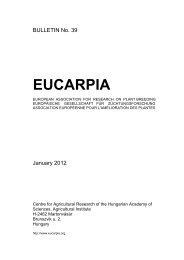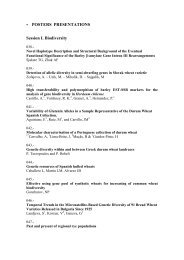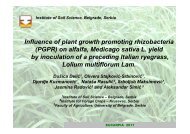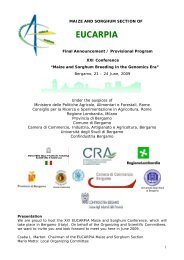Plant breeding for organic and sustainable, low-input agriculture
Plant breeding for organic and sustainable, low-input agriculture
Plant breeding for organic and sustainable, low-input agriculture
You also want an ePaper? Increase the reach of your titles
YUMPU automatically turns print PDFs into web optimized ePapers that Google loves.
Dynamics of doubled haploidy <strong>breeding</strong> <strong>and</strong> molecular cytogenetic approaches vis-a-vis<br />
genetic upgradation of bread wheat <strong>for</strong> <strong>organic</strong> <strong>and</strong> <strong>low</strong> <strong>input</strong> farming systems in northwest<br />
Himalayas<br />
Harinder K. Chaudhary, Rakesh K. Chahota, Naval Kishore, Vijay Kumar, Shailesh P. Sood<br />
Molecular Cytogenetics & Tissue Culture Lab, CSK HP Agricultural University, Palampur, India<br />
Bread wheat (Triticum aestivum L.), one of the major cereals of north-west Himalayas is<br />
cultivated under varied agroclimatic situations <strong>and</strong> farming systems in the hills <strong>and</strong> mountainous<br />
tracts of this zone. Some of the progressive & tribal farming communities of these Himalayan<br />
mountains have adopted a practice of <strong>organic</strong> farming system since last decade. The diverse<br />
genotypes of winter <strong>and</strong> spring wheat ecotypes cultivated in different regions are very <strong>low</strong><br />
yielding <strong>and</strong> highly susceptible to the rusts <strong>and</strong> powdery mildew hence, there is a dire need to<br />
genetically upgrade these genotypes <strong>for</strong> developing the elite stocks to be cultivated under <strong>organic</strong><br />
<strong>and</strong> <strong>low</strong> <strong>input</strong> farming systems.<br />
The north-west Himalayan germplasm resources in respect of winter <strong>and</strong> spring wheat ecotypes<br />
<strong>and</strong> rye have been used <strong>for</strong> the introgression of the target genes. The <strong>breeding</strong> programmes have<br />
been accelerated with enhanced precision <strong>and</strong> efficiency fol<strong>low</strong>ing chromosome elimination<br />
technique (Chaudhary et al., 2005) <strong>and</strong> novel tools of molecular cytogenetic approach (Mukai et<br />
al., 1989).<br />
The ongoing wheat improvement endeavour <strong>for</strong> the genetic upgradation of local genotypes in<br />
this Lab has been expedited through the application of novel tools of the doubled haploidy (DH)<br />
<strong>breeding</strong> <strong>and</strong> molecular cytogenetic approaches by a team of North-West Himalayan Crop<br />
Improvement & Genome Research Group. The chromosome elimination-mediated approach of<br />
DH <strong>breeding</strong> has curtailed the time period to develop the new-recombinants derived from the<br />
triticale x wheat (introgressed rye genes into wheat) <strong>and</strong> winter x spring wheat (introgression of<br />
the gene pools of winter <strong>and</strong> spring ecotypes) hybridization. The genomic in situ hybridization<br />
(GISH) <strong>and</strong> fluorescene in situ hybridization (FISH) has further enhanced the efficiency of<br />
selection of elite recombinants carrying targeted introgressions needed <strong>for</strong> the <strong>organic</strong> farming<br />
<strong>and</strong> <strong>low</strong> <strong>input</strong> management systems of the north west Himalayan regions. About 150 DH lines<br />
developed in Molecular Cytogenetics & Tissue Culture Lab of this Department by involving the<br />
local l<strong>and</strong> races of winter <strong>and</strong> spring wheat ecotypes fol<strong>low</strong>ing chromosome- elimination<br />
mediated system <strong>and</strong> the molecular cytogenetic approaches are being screened under highly<br />
diverse agroclimatic situations <strong>for</strong> further recommendations to the <strong>organic</strong> <strong>and</strong> <strong>low</strong> <strong>input</strong> farming<br />
systems.<br />
54


